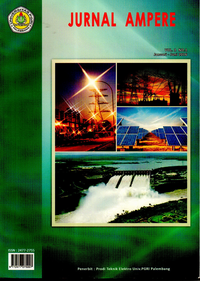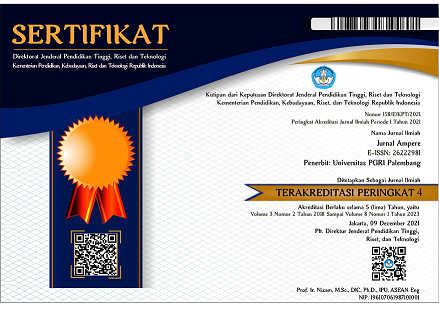PERANCANGAN SISTEM KUNCI PINTU OTOMATIS MENGUNAKAN RFID ARDUINO UNO
DOI:
https://doi.org/10.31851/ampere.v6i1.5242Keywords:
Arduino Uno, RFID, Relay, Selenoid Lock Door, LCDAbstract
Pada pembuatan alat ini saya menggunkan arduino uno, relay, RFID, LCD MFRC522, LCD 16x2, kabel jumper, adaptor 12v, Selenoid lock door, dan resistor. Tujuan pembuatan alat ini adalah untuk merancang kunci pintu otomatis di gedung yang telah terenkripsi dengan chip serta menambah keamanan di gedung yang ada di Perkantoran. Pembuatan alat ini diterapkan pada pintu miniatur yang menyerupai bentuk sesungguhnya. Cara kerja alat ini adalah arduino uno mengirimkan sinyal keluaran ke LCD dan Relay, relay yang mendapat sinyal perintah dari arduino uno bertindak sebagai saklar sehingga kondisi relay bisa ON atau OFF, lalu selenoid look door akan bekerja saat relay dalam keadaan ON maka kunci akan aktif saat selenoid look door bekerja.
References
Rahman, U., & Shahid, F. (2013). RFID Based Library Management System.
Miles, S. B, Sanjay E. Sarma & John R. Williams. 2008. RFID Technology and Applications. Cambridge University Press, New York.
Ajang, Rahmat. 2018. Belajar Pemrograman Dasar Arduino. https://kelasrobot.com/belajar-pemrograman-dasar-arduino/
Board Arduino Uno-R3 (Hari Santoso, 2015 : 2
Sweeney II PJ. 2008. RFID for Dummies. Wiley Publishing. Canada.
Downloads
Additional Files
Published
How to Cite
Issue
Section
License

Jurnal Ampere is licensed under a Creative Commons Attribution-ShareAlike 4.0 International License.
Authors who publish with this journal agree to the following terms:
- Authors retain copyright and grant the journal right of first publication with the work simultaneously licensed under a Creative Commons Attribution License that allows others to share the work with an acknowledgement of the work's authorship and initial publication in this journal.
- Authors are able to enter into separate, additional contractual arrangements for the non-exclusive distribution of the journal's published version of the work (e.g., post it to an institutional repository or publish it in a book), with an acknowledgement of its initial publication in this journal.
- Authors are permitted and encouraged to post their work online (e.g., in institutional repositories or on their website) prior to and during the submission process, as it can lead to productive exchanges, as well as earlier and greater citation of published work.






